Cisco Aironet 1530 シリーズ屋外アクセス ポイント ハードウェア インストレーション ガイド
偏向のない言語
この製品のマニュアルセットは、偏向のない言語を使用するように配慮されています。このマニュアルセットでの偏向のない言語とは、年齢、障害、性別、人種的アイデンティティ、民族的アイデンティティ、性的指向、社会経済的地位、およびインターセクショナリティに基づく差別を意味しない言語として定義されています。製品ソフトウェアのユーザーインターフェイスにハードコードされている言語、RFP のドキュメントに基づいて使用されている言語、または参照されているサードパーティ製品で使用されている言語によりドキュメントに例外が存在する場合があります。シスコのインクルーシブランゲージに対する取り組みの詳細は、こちらをご覧ください。
翻訳について
このドキュメントは、米国シスコ発行ドキュメントの参考和訳です。リンク情報につきましては、日本語版掲載時点で、英語版にアップデートがあり、リンク先のページが移動/変更されている場合がありますことをご了承ください。あくまでも参考和訳となりますので、正式な内容については米国サイトのドキュメントを参照ください。
- Updated:
- 2017年5月30日
章のタイトル: 適合宣言および規制情報
- 製造業者による連邦通信委員会への適合宣言
- Industry Canada
- Declaration of Conformity for RF Exposure
- European Community, Switzerland, Norway, Iceland, and Liechtenstein
- Declaration of Conformity with regard to the R&TTE Directive 1999/5/EC & Medical Directive 93/42/EEC
- RF 被曝に関する適合宣言
- Cisco Aironet アクセス ポイントの使用に関するガイドライン(日本の場合)
- Administrative Rules for Cisco Aironet Access Points in Taiwan
- Operation of Cisco Aironet Access Points in Brazil
適合宣言および規制情報
この付録では、Cisco Aironet 1532 屋外アクセス ポイントに関する適合宣言と規制情報について説明します。
•![]() 「European Community, Switzerland, Norway, Iceland, and Liechtenstein」
「European Community, Switzerland, Norway, Iceland, and Liechtenstein」
•![]() 「Cisco Aironet アクセス ポイントの使用に関するガイドライン(日本の場合)」
「Cisco Aironet アクセス ポイントの使用に関するガイドライン(日本の場合)」
•![]() 「Administrative Rules for Cisco Aironet Access Points in Taiwan」
「Administrative Rules for Cisco Aironet Access Points in Taiwan」
製造業者による連邦通信委員会への適合宣言
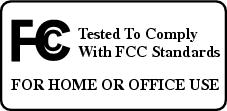
Cisco Systems, Inc.
170 West Tasman Drive
San Jose, CA 95134-1706
USA
このデバイスは、Part 15 の規定に適合しており、 動作は次の 2 つの条件を前提としています。
1.![]() このデバイスによって、有害な干渉が発生することはない。
このデバイスによって、有害な干渉が発生することはない。
2.![]() このデバイスは、予想外の動作を引き起こす可能性のある干渉も含め、すべての干渉を受け入れなければならない。
このデバイスは、予想外の動作を引き起こす可能性のある干渉も含め、すべての干渉を受け入れなければならない。
この機器は、FCC 規定の Part 15 に基づくクラス A デジタル デバイスの制限に準拠していることがテストによって確認済みです。制限は、住宅地で機器を使用した場合に有害な干渉が起きないようにするための、一定の保護を目的としたものです。この機器は無線周波エネルギーを生成、使用、および放射するため、指示に従わずに取り付けたり使用したりした場合は、有害な干渉を発生させるおそれがあります。ただし、説明書に従った場合にも、干渉が起きないことを保証するものではありません。この機器によってラジオやテレビの受信に干渉が発生する場合は(機器の電源をオン/オフすることで確認できます)、次のいずれかの方法で干渉をなくすようにしてください。
•![]() 受信装置が接続されている回路とは別の回路のコンセントに機器を接続する。
受信装置が接続されている回路とは別の回路のコンセントに機器を接続する。


Industry Canada
Models: IC Certification Number:
Canadian Compliance Statement
This Class A Digital apparatus meets all the requirements of the Canadian Interference-Causing Equipment Regulations.
Cet appareil numerique de la classe A respecte les exigences du Reglement sur le material broilleur du Canada.
This device complies with Class A Limits of Industry Canada. Operation is subject to the following two conditions:
1.![]() This device may not cause harmful interference, and
This device may not cause harmful interference, and
2.![]() This device must accept any interference received, including interference that may cause undesired operation.
This device must accept any interference received, including interference that may cause undesired operation.
Cisco Aironet Access Points are certified to the requirements of RSS-210. The use of this device in a system operating either partially or completely outdoors may require the user to obtain a license for the system according to the Canadian regulations. For further information, contact your local Industry Canada office.
This device has been designed to operate with antennas having a maximum gain of 13 dBi for 2.4 GHz and 14 dBi for 5 GHz. Antennas having a gain greater are strictly prohibited for use with this device. The required antenna impedance is 50 ohms.
To reduce potential radio interference to other users, the antenna type and its gain should be so chosen that the equivalent isotropically radiated power (EIRP) is not more than that permitted for successful communication.
Declaration of Conformity for RF Exposure
This access point product has been found to be compliant to the requirements set forth in CFR 47
Section 1.1307 addressing RF Exposure from radio frequency devices as defined in Evaluating Compliance with FCC Guidelines for Human Exposure to Radio Frequency Electromagnetic Fields. Antennas that have 8 dBi to 14 dBi gain should be located at a minimum of 19.7 inches (50 cm) or more from the body of all persons. Antennas that have less than 8 dBi gain should be located at a minimum of 7.9 inches (20 cm) or more from the body of all persons.
This access point is also compliant to EN 50835 for RF exposure.
European Community, Switzerland, Norway, Iceland, and Liechtenstein
Declaration of Conformity with regard to the R&TTE Directive 1999/5/EC & Medical Directive 93/42/EEC
This declaration is only valid for configurations (combinations of software, firmware, and hardware) provided and supported by Cisco Systems. The use of software or firmware not provided and supported by Cisco Systems may result in the equipment no longer being compliant with the regulatory requirements.
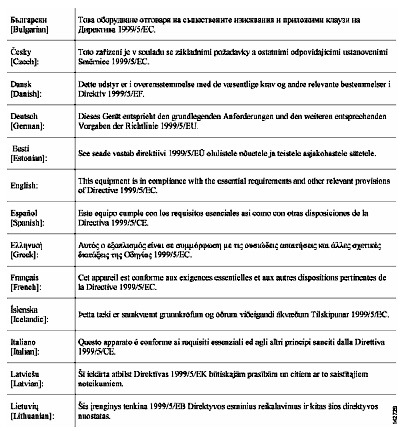
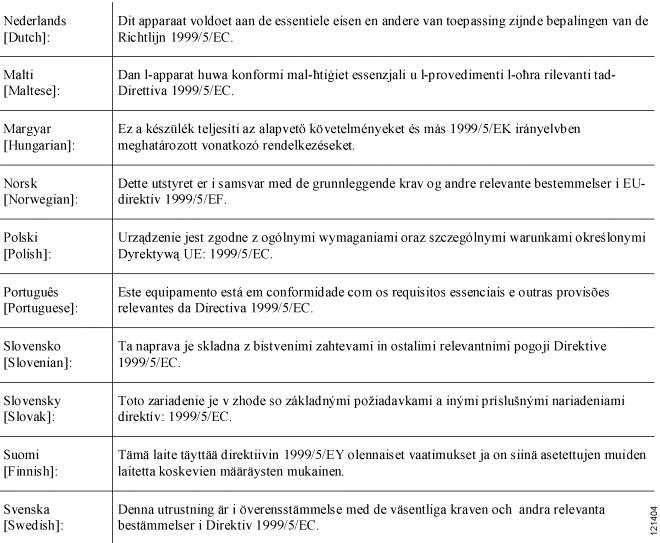
The following standards were applied:
EMC--EN 301.489-1 v1.8.1; EN 301.489-17 v2.1.1
Health & Safety--EN60950-1: 2005; EN 50385: 2002
Radio--EN 300 328 v 1.7.1; EN 301.893 v 1.5.1
The conformity assessment procedure referred to in Article 10.4 and Annex III of Directive 1999/5/EC has been followed.
This device also conforms to the EMC requirements of the Medical Devices Directive 93/42/EEC.

(注) This equipment is intended to be used in all EU and EFTA countries. Outdoor use may be restricted to certain frequencies and/or may require a license for operation. For more details, contact Cisco Corporate Compliance.
The product carries the CE Mark:

RF 被曝に関する適合宣言
米国、カナダ、欧州連合、およびオーストラリアの RF 被曝に関する適合宣言を次に示します。
米国
このシステムは、ANSI C 95.1(米国規格協会)の制限値を基準として、人体に対する RF 被曝レベルが評価されています。
この評価は ANSI C 95.1 および FCC OET Bulletin 65C rev 01.01 に基づいています。
コンプライアンスを維持するための、8 dBi ~ 14 dBi のゲインを持つアンテナに対する最低分離距離は、人体から 19.7 インチ(50 cm)です。8 dBi 未満のゲインを持つアンテナから人体への最低分離距離は 7.9 インチ(20 cm)です。
カナダ
このシステムは、ANSI C 95.1(米国規格協会)の制限値を基準として、人体に対する RF 被曝レベルが評価されています。
この評価は RSS-102 Rev 2 に基づいています。コンプライアンスを維持するための、8 dBi ~ 14 dBi のゲインを持つアンテナに対する最低分離距離は、人体から 19.7 インチ(50 cm)です。8 dBi 以下のゲインを持つアンテナから人体の最低分離距離は 7.9 インチ(20 cm)です。
欧州連合
このシステムは、ICNIRP(International Commission on Non-Ionizing Radiation Protection)の制限値を基準として、人体に対する RF 被曝レベルが評価されています。
評価は、EN 50385「Product Standard to Demonstrate Compliance of Radio Base stations and Fixed Terminals for Wireless Telecommunications Systems with basic restrictions or reference levels related to Human Exposure to Radio Frequency Electromagnetic Fields from 300 MHz to 40 GHz」に基づいています。
コンプライアンスを維持するための、8 dBi ~ 14 dBi のゲインを持つアンテナに対する最低分離距離は、人体から 19.7 インチ(50 cm)です。8 dBi 未満のゲインを持つアンテナから人体への最低分離距離は 7.9 インチ(20 cm)です。
オーストラリア
このシステムは、Australian Radiation Protection 規格に基づき、ICNIRP(International Commission on Non-Ionizing Radiation Protection)の制限値を基準として、人体に対する RF 被曝レベルが評価されています。
コンプライアンスを維持するための、8 dBi ~ 14 dBi のゲインを持つアンテナに対する最低分離距離は、人体から 19.7 インチ(50 cm)です。8 dBi 未満のゲインを持つアンテナから人体への最低分離距離は 7.9 インチ(20 cm)です。
Cisco Aironet アクセス ポイントの使用に関するガイドライン(日本の場合)
この項では、日本で Cisco Aironet アクセス ポイントを使用する際に、干渉を回避するためのガイドラインを示します。このガイドラインは、日本語と英語で提供されています。
日本語
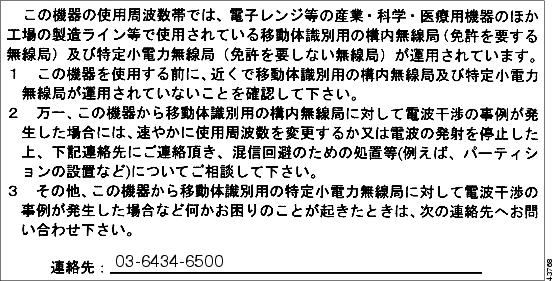
English Translation
This equipment operates in the same frequency bandwidth as industrial, scientific, and medical devices such as microwave ovens and mobile object identification (RF-ID) systems (licensed premises radio stations and unlicensed specified low-power radio stations) used in factory production lines.
1.![]() Before using this equipment, make sure that no premises radio stations or specified low-power radio stations of RF-ID are used in the vicinity.
Before using this equipment, make sure that no premises radio stations or specified low-power radio stations of RF-ID are used in the vicinity.
2.![]() If this equipment causes RF interference to a premises radio station of RF-ID, promptly change the frequency or stop using the device; contact the number below and ask for recommendations on avoiding radio interference, such as setting partitions.
If this equipment causes RF interference to a premises radio station of RF-ID, promptly change the frequency or stop using the device; contact the number below and ask for recommendations on avoiding radio interference, such as setting partitions.
3.![]() If this equipment causes RF interference to a specified low-power radio station of RF-ID, contact the number below.
If this equipment causes RF interference to a specified low-power radio station of RF-ID, contact the number below.
VCCI Statement for Japan

|
|

|

|
Administrative Rules for Cisco Aironet Access Points in Taiwan
This section provides administrative rules for operating Cisco Aironet Access Points in Taiwan. The rules are provided in both Chinese and English.
Chinese Translation
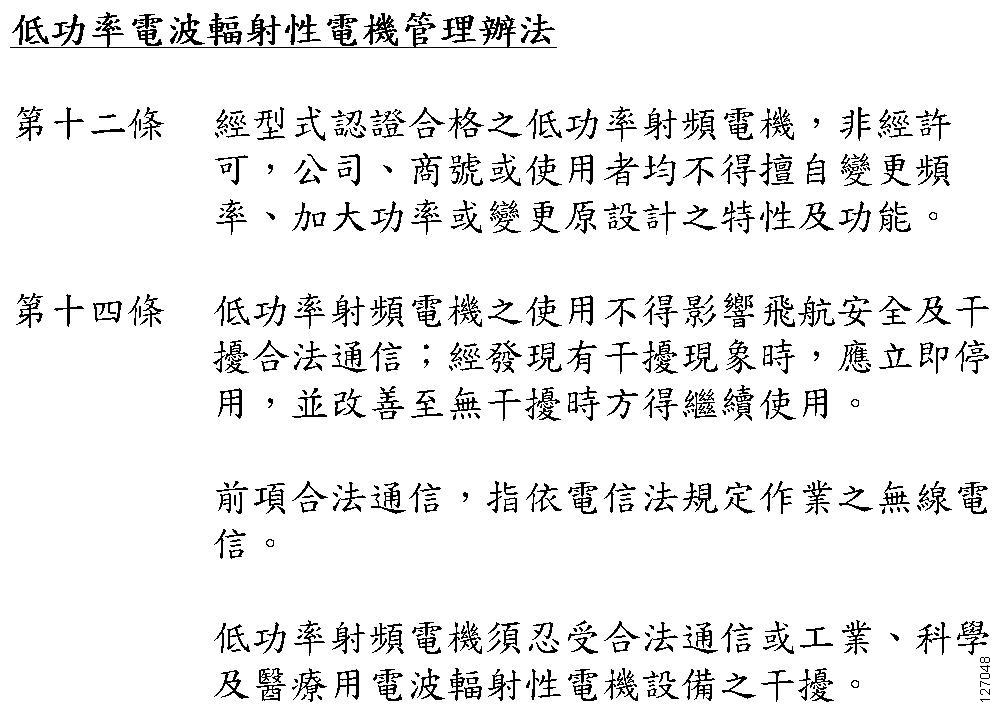
English Translation
Administrative Rules for Low-power Radio-Frequency Devices
For those low-power radio-frequency devices that have already received a type-approval, companies, business units or users should not change its frequencies, increase its power or change its original features and functions.
The operation of the low-power radio-frequency devices is subject to the conditions that no harmful interference is caused to aviation safety and authorized radio station; and if interference is caused, the user must stop operating the device immediately and can't re-operate it until the harmful interference is clear.
The authorized radio station means a radio-communication service operating in accordance with the Communication Act.
The operation of the low-power radio-frequency devices is subject to the interference caused by the operation of an authorized radio station, by another intentional or unintentional radiator, by industrial, scientific and medical (ISM) equipment, or by an incidental radiator.
Chinese Translation
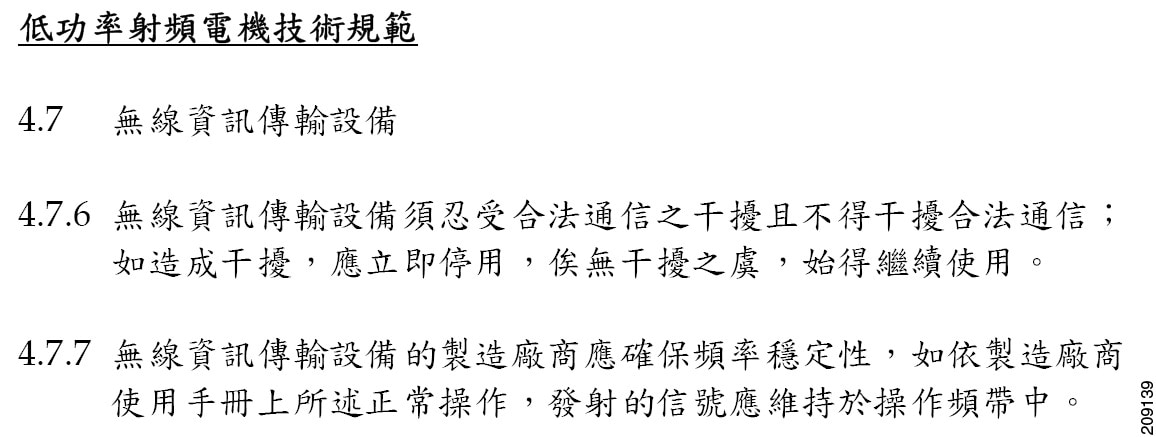
English Translation
Low-power Radio-frequency Devices Technical Specifications
Unlicensed National Information Infrastructure
The U-NII devices shall accept any interference from legal communications and shall not interfere the legal communications. If interference is caused, the user must stop operating the device immediately and can't re-operate it until the harmful interference is clear.
Manufacturers of U-NII devices are responsible for ensuring frequency stability such that an emission is maintained within the band of operation under all conditions of normal operation as specified in the user manual.
ステートメント 371:電源ケーブルおよび AC アダプタ

English Translation
When installing the product, please use the provided or designated connection cables/power cables/AC adapters. Using any other cables/adapters could cause a malfunction or a fire. Electrical Appliance and Material Safety Law prohibits the use of UL-certified cables (that have the "UL" shown on the code) for any other electrical devices than products designated by CISCO. The use of cables that are certified by Electrical Appliance and Material Safety Law (that have "PSE" shown on the code) is not limited to CISCO-designated products.
EU Declaration of Conformity
All the Declaration of Conformity statements related to this product can be found at the following location:
Operation of Cisco Aironet Access Points in Brazil
This section contains special information for operation of Cisco Aironet access points in Brazil.
Access Point Models
Regulatory Information
Figure B-1 contains Brazil regulatory information for the access point models identified in the previous section.
Figure B-1 Brazil Regulatory Information

Portuguese Translation
Este equipamento opera em caráter secundário, isto é, não tem direito a proteção contra interferência prejudicial, mesmo de estações do mesmo tipo, e não pode causar interferência a sistemas operando em caráter primário.
English Translation
This equipment operates on a secondary basis and consequently must accept harmful interference, including interference from stations of the same kind. This equipment may not cause harmful interference to systems operating on a primary basis.
 フィードバック
フィードバック